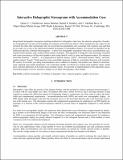| dc.contributor.author | Smithwick, Quinn Y. J. | |
| dc.contributor.author | Barabas, James D. | |
| dc.contributor.author | Smalley, Daniel E. | |
| dc.contributor.author | Bove, V. Michael, Jr. | |
| dc.date.accessioned | 2010-09-16T16:25:39Z | |
| dc.date.available | 2010-09-16T16:25:39Z | |
| dc.date.issued | 2010-02 | |
| dc.date.submitted | 2010-01 | |
| dc.identifier.issn | 0277-786X | |
| dc.identifier.other | Proc. SPIE, Vol. 7619, 761903 (2010) | |
| dc.identifier.uri | http://hdl.handle.net/1721.1/58564 | |
| dc.description.abstract | Image-based holographic stereogram rendering methods for holographic video have the attractive properties of moderate computational cost and correct handling of occlusions and translucent objects. These methods are also subject to the criticism that (like other stereograms) they do not present accommodation cues consistent with vergence cues and thus do not make use of one of the significant potential advantages of holographic displays. We present an algorithm for the Diffraction Specific Coherent Panoramagram -- a multi-view holographic stereogram with correct accommodation cues, smooth motion parallax, and visually defined centers of parallax. The algorithm is designed to take advantage of parallel and vector processing in off-the-shelf graphics cards using OpenGL with Cg vertex and fragment shaders. We introduce wavefront elements - "wafels" - as a progression of picture element "pixels", directional element "direls", and holographic element "hogels". Wafel apertures emit controllable intensities of light in controllable directions with controllable centers of curvature, providing accommodation cues in addition to disparity and parallax cues. Based on simultaneously captured scene depth information, sets of directed variable wavefronts are created using nonlinear chirps, which allow coherent diffraction of the beam across multiple wafels. We describe an implementation of this algorithm using a commodity graphics card for interactive display on our Mark II holographic video display. | en_US |
| dc.description.sponsorship | Things That Think Consortium | en_US |
| dc.description.sponsorship | DigitalLife | en_US |
| dc.description.sponsorship | Massachusetts Institute of Technology. Media Laboratory. Consumer Electronics Laboratory | en_US |
| dc.description.sponsorship | Massachusetts Institute of Technology. Media Laboratory. Center for Future Storytelling | en_US |
| dc.language.iso | en_US | |
| dc.publisher | SPIE | en_US |
| dc.relation.isversionof | http://dx.doi.org/10.1117/12.840526 | en_US |
| dc.rights | Article is made available in accordance with the publisher's policy and may be subject to US copyright law. Please refer to the publisher's site for terms of use. | en_US |
| dc.source | SPIE | en_US |
| dc.title | Interactive Holographic Stereograms with Accommodation Cues | en_US |
| dc.type | Article | en_US |
| dc.identifier.citation | Smithwick, Quinn Y. J. et al. “Interactive holographic stereograms with accommodation cues.” Practical Holography XXIV: Materials and Applications. Ed. Hans I. Bjelkhagen & Raymond K. Kostuk. San Francisco, California, USA: SPIE, 2010. 761903-13. ©2010 SPIE. | en_US |
| dc.contributor.department | Massachusetts Institute of Technology. Media Laboratory | en_US |
| dc.contributor.approver | Bove, V. Michael, Jr. | |
| dc.contributor.mitauthor | Smithwick, Quinn Y. J. | |
| dc.contributor.mitauthor | Barabas, James D. | |
| dc.contributor.mitauthor | Smalley, Daniel E. | |
| dc.contributor.mitauthor | Bove, V. Michael, Jr. | |
| dc.relation.journal | Proceedings of SPIE--the International Society for Optical Engineering | en_US |
| dc.eprint.version | Final published version | en_US |
| dc.type.uri | http://purl.org/eprint/type/JournalArticle | en_US |
| eprint.status | http://purl.org/eprint/status/PeerReviewed | en_US |
| dspace.orderedauthors | Smithwick, Quinn Y. J.; Barabas, James; Smalley, Daniel E.; Bove, Jr., V. Michael | en |
| mit.license | PUBLISHER_POLICY | en_US |
| mit.metadata.status | Complete | |
